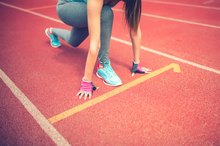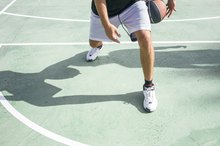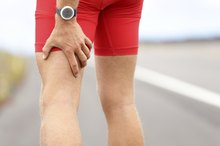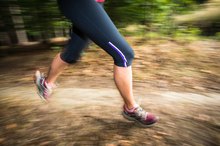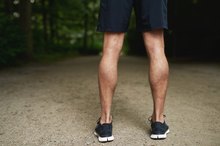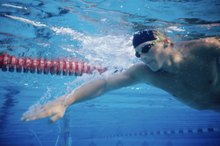Your Thighs Hurt After Football Practices
The explosive movements in football place a great deal of stress on your thigh or quadriceps muscles. Overtraining, improper warm-up or muscle tightness can lead to injury and thigh pain. Treatment includes rest, ice and over-the-counter pain medications. If pain persists or worsens, consult your physician or athletic trainer.
If you are experiencing serious medical symptoms, seek emergency treatment immediately.
Risk Factors
Not properly warming up prior to football practice and inadequate stretching might cause tight muscles and increase your risk of muscle soreness and injury. Overtraining also greatly increases your risk of experiencing muscle pain, including thigh pain. The book “Overtraining in Sports” says overtraining might cause negative changes to the strength and flexibility of muscles, which might make them more prone to injury. Other risk factors include dehydration, muscle strength imbalances and improper training techniques.
- Not properly warming up prior to football practice and inadequate stretching might cause tight muscles and increase your risk of muscle soreness and injury.
- Overtraining also greatly increases your risk of experiencing muscle pain, including thigh pain.
Injuries
How to Rehab a Suspensory Strain
Learn More
A strain of your quadriceps muscles can lead to thigh pain following football. A muscle strain is when you overstretch or tear your muscle, which causes pain, inflammation and muscle weakness. Another cause for thigh pain is delayed onset muscle soreness, or DOMS. According to a 2003 University of New Mexico article, damage to your muscles and an inflammatory response following intense exercise are the primary causes of DOMS 3. Therefore, high-intensity football practices can lead to DOMS and thigh pain or soreness. Because football is a contact sport, a bruise or contusion on your thigh from a direct hit can lead to thigh pain as well.
- A strain of your quadriceps muscles can lead to thigh pain following football.
- A muscle strain is when you overstretch or tear your muscle, which causes pain, inflammation and muscle weakness.
Treatment and Rehabilitation
Rest, ice and take over-the-counter pain medication to alleviate pain and swelling. You can also wear a compression wrap to help provide support and reduce swelling. After the first 48 to 72 hours, you may apply heat to increase blood flow to your thigh muscles and to promote healing. Perform light stretches and strengthening exercises to regain strength and flexibility before returning to football practices. Beneficial stretches include a standing quad stretch and lunge stretch, and common exercises are the knee extension and squats. Hold stretches for approximately 30 seconds and perform one to three times daily. For strengthening exercises, perform two to three sets of 10 to 20 repetitions, two to three days a week.
- Rest, ice and take over-the-counter pain medication to alleviate pain and swelling.
- After the first 48 to 72 hours, you may apply heat to increase blood flow to your thigh muscles and to promote healing.
Prevention
Knee Injuries & Sprinting
Learn More
Warm up with light exercises or a jog and stretch after football practices to prevent muscle pain or soreness. Progress slowly with your football training and allow adequate recovery time between workouts to prevent overtraining. Eat a healthy diet, stay hydrated and get adequate sleep to further reduce your risk of sustaining a quadriceps strain or DOMS.
- Warm up with light exercises or a jog and stretch after football practices to prevent muscle pain or soreness.
- Eat a healthy diet, stay hydrated and get adequate sleep to further reduce your risk of sustaining a quadriceps strain or DOMS.
Related Articles
References
- American Academy of Orthopaedic Surgeons: Muscle Strains in The Thigh
- “Overtraining in Sport”; "Musculoskeletal and Orthopedic Considerations"; W. Ben Kibler et al; 1998
- University of New Mexico; "Treating and Preventing DOMS"; John David Maes et al; 2003
- Koh ZSD, Lin S, Hey HWD. Lumbar disc herniation presenting with contralateral symptoms: a case report. J Spine Surg. 2017;3(1):92-94. doi:10.21037/jss.2017.03.06
- Genevay S, Atlas SJ. Lumbar spinal stenosis. Best Pract Res Clin Rheumatol. 2010;24(2):253-65. doi:10.1016/j.berh.2009.11.001
- Sherry M. Examination and treatment of hamstring related injuries. Sports Health. 2012;4(2):107-14. doi:10.1177/1941738111430197
- Lavine R. Iliotibial band friction syndrome. Curr Rev Musculoskelet Med. 2010;3(1-4):18-22. doi:10.1007/s12178-010-9061-8
- Ryan AS, Buscemi A, Forrester L, Hafer-macko CE, Ivey FM. Atrophy and intramuscular fat in specific muscles of the thigh: associated weakness and hyperinsulinemia in stroke survivors. Neurorehabil Neural Repair. 2011;25(9):865-72. doi:10.1177/1545968311408920
- Centers for Disease Control and Prevention. Understanding Blood Clots. Updated March 14, 2019.
- Cherkin DC, Sherman KJ, Avins AL, et al. A randomized trial comparing acupuncture, simulated acupuncture, and usual care for chronic low back pain. Arch Intern Med. 2009;169(9):858-66. doi:10.1001/archinternmed.2009.65
- Lempainen L. Operative treatment for the painful posterior thigh after hamstring autograft harvesting. Muscles, Ligaments and Tendons Journal. 2017;7(3):570. doi:10.11138/mltj/2017.7.3.570
Writer Bio
Since 2007 Hannah Mich has written e-newsletters and been published in the "Missouri Journal of Health, Physical Education, Recreation and Dance." She has a Bachelor of Science in exercise science from Truman State University and a Master of Education in applied kinesiology from the University of Minnesota.

